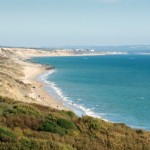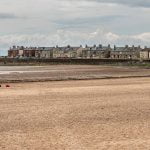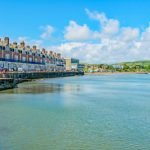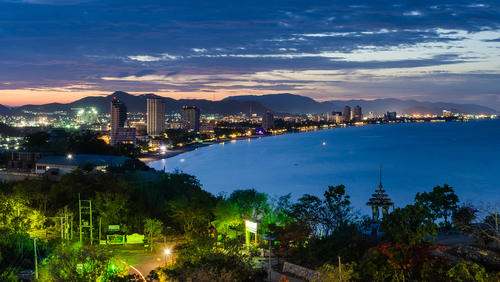
A quick guide to Hua Hin
Hua Hin is a city and beach resort situated on Thailand’s southeast coast in the province of Prachuap Khiri Khan. It lies directly opposite its infamous and markedly unrulier neighbour of Pattaya, some 108 km (68 miles) across the Gulf of Thailand and 548 km (343 miles) north of the distinctly more glamourous Phuket. However, Hua Hin is about a two and a half-hour drive from Bangkok (200 km) and is particularly favoured by Thais and ex-pats alike. While these days, Hua Hin could hardly be described as tranquil, with thousands flocking from the capital each weekend, the town does have a patently more ‘Thai’ and ‘chilled out’ feel than any of the country’s major seaside resorts. In 2017, the resident population of Hua Hin was estimated at 61,097.
A Fleeting History
Hua Hin is Thailand’s oldest beach resort but up until the early 20th century it was little more than a fishing village. In 1834, the first settlers of the area came in the form of a small group of farmers from Phetchaburi Province who had moved southwards when their farmsteads were hit by severe drought. They settled in the area giving it the name Samore (aka Samo) Riang, meaning ‘rows of rock’.
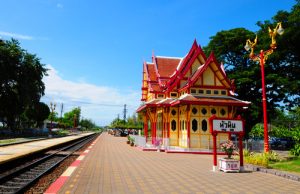
Hua Hin’s iconic railway station built in 1926
However, it wasn’t until the 1920s that the area became popularised when the place was made a stop on the newly opened Bangkok to Malaysia railway. In 1921 the director of the state railway, Prince Purachatra, built the ‘Railway Hotel’ close to the beach, originally as an overnight stopover on the three-day rail journey to Malaysia. At the same time, Prince Krom Phra Naresworarit had a palace built at Ban Laem Hin. He named the beach next to his palace as “Hua Hin” (Stone Head), which eventually became the adopted name of the town. Again at the much same time, Rama VI commissioned the nine-hole Royal Hua Hin Golf Course (now 18 holes) to be built a little to the west of the station. Soon after in 1926, Rama VII had his own summer palace built in the town, Klai Klang Won (“Far from Worries”).
The once secluded fishing village had quickly evolved into the Royal resort and soon became a firm favourite with Siam’s elite and wealthy foreign travellers, alike. Not long after the southern railway opened, the cost of rail travel began to fall, opening up ready access to Hua Hin to the wider Thai public. It became the first recognised beach resort in Thailand with the wealthy of Bangkok soon flocking to its shores in significant numbers.
Between 2004 and 2006, the Klai Klang Won Summer Palace became the full-time residence of King Bhumipol Adulyadej (Rama IX), before health issues forced him to return to Bangkok, where appropriate medical treatment was closer at hand. King Bhumipol died in 2016, aged 88, after ruling Thailand for 70 years.
Perhaps more than anything, due to its royal connections, Hua Hin’s development over the last 30 years has been more constrained than many places elsewhere in Thailand. The town centre has retained its essential Thai character since most of the expansion has taken place linearly along the main road.
Climate
In general, Hua Hin obviously has a tropical climate with high humidity. However, it is recognised as having one of the best all-year-round climates in Thailand. Like the rest of the country, the best time of the year to visit Hua Hin is in the cool season from November to February, when humidity levels are low. For those who like to see the mercury rising, then the hot season is from March to May when temperatures can be expected to be well up into the 30s °C. The rainy season is from June to October, with September being the wettest month. However, the area generally escapes the worst of the Thai monsoon, and normally it won’t rain every day. When it does rain, it usually comes in short sharp bursts, with skies overcast, and often being fairly humid.
Getting there!
By train
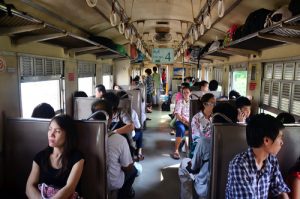
3rd class train travel – a cheap way to get to Hua Hin. (Credit to Anirut Thailand/Shutterstock.com)
By train is by far the least stressful and cheapest way to get to Hua Hin. The journey takes between 3 1/2 and 4 1/2 hours depending on what class of train you catch. The fare depends on the train type i.e. special, express, rapid or ordinary, and the class of your ticket. There are 11 trains that leave Bangkok’s central station Hua Lamphong daily between the times of 8 am and 11 pm. Third-class on an ordinary train to my mind offers a reasonable level of comfort – and it’s air-conditioned – as all the windows are usually fully open! A ticket in third-class will set you back the princely THB 45 (i.e. £1/US$1.5). Hua Hin station is right in the middle of town, so you can easily walk to accommodation if you’ve booked, or are looking to stay, in a central location. Tickets may be purchased online but you should have no problem buying one just before your journey.
By bus
There’s a regular bus service to Hua Hin leave from the Sai Tai Mai (Southern) terminal in Bangkok that takes around 3½ hr. However, the terminal is well out of the centre of Bangkok. The most cost-effective way to get there is to take the Sky Train to the terminal station on the Silom Line, Bang Wa. However, from there you will need to take a taxi as its about another 10 km (6 miles). While taxis are very cheap in Bangkok, getting a metred taxi is getting more and more difficult, so you may well have to negotiate a price with the driver. The metered fare is around THB 100. The bus terminal in Hua Hin is 7 km north of town centre, near the Hua Hin Airport on Phetkasem Road.
There are also buses to/from Suvarnabhumi (Bangkok) Airport and Hua Hin, operated by the Roong Reuang Coach Company.
By mini-van
A popular and quick way to get to Hua Hin from Bangkok is by minivan. However, as in the past, services no longer depart from Victory Monument in the centre of Bangkok. Minivan services to Hua Hin now depart from Sai Tai Mai and Ekkamai Bus Stations. Travel time can be as little as 3 hours (though very much ‘traffic’ dependent) from Bangkok. You will be dropped at Hua Hin bus station, but there is a ‘free’ mini-bus service provided by the bus company, into town. Ask for the ‘clock tower’ if you are looking to get off near the town centre.
By taxi
Many taxis from Bangkok will be available for the 200 km journey, with a price (after negotiation) of around THB 2,000 (£50/US$65). It’s a little further from Bangkok Airport but the price will be around the same price. Limousine service, available at Bangkok Airport, will be a bit more expensive.
By ferry (From/to Pattaya)
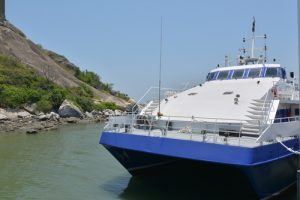
The ferry from Pattaya only takes just over 2 hours
There is a daily ferry passenger service between Hua Hin and Pattaya, across the Gulf of Thailand. The catamaran service operated by Royal Passenger Liner Co, Ltd. can take up to 346 passengers. A single ferry leaves Pattaya at 13:00 daily, arriving Hua Hin at 15:00. Then it leaves Hua Hin at 16:00, arriving in Pattaya at 18:00. The ferry port in Hua Hin is about 7 km south of the town. The songthaew (Thai style shared taxi) costs THB 200 (£5) per person into town. If you’re travelling light and prepared to walk a little to the main road, you can get the same ride for a tenth of the cost from one of the regular songthaews that drive the beach road. In high season, you might well find these taxis to be packed full.
By Air
Currently, there are no domestic flights to/from Hua Hin Airport. The only international flight is from/to Kuala Lumpur, which arrives at 11.10 am on M W F Su and departs at 11.40 am on the same days.
Things to see and do!
You won’t be stuck for things to see and do around Hua Hin. There are world-class golf courses, driving ranges, the Royal Palace, horseriding, waterparks, a vineyard, waterfalls, markets, shopping centres, an elephant village, mountain biking, kite surfing, as well as good beaches and lively nightlife, to name just some. Here are a few recommendations:
Kite surfing
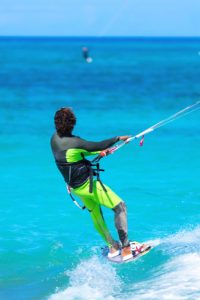
There’s great kite-surfing in Hua Hin
Hua Hin is certainly Thailand’s top kite surfing beach and one of the best in Asia. During Thailand’s cool season, i.e. from December to March, there’s normally a strong, steady wind that blows across the Gulf of Thailand. The breeze is normally of a strength that generates waves of just the right magnitude that create ideal conditions for windsurfing. You will find tens of schools set up along the beach, all of which offer tuition for the novice surfer.
Golf
Golf is big throughout Thailand, being a particular favourite with Thais. There are also many ex-pats and foreign tourists who come to Hua Hin for the world-class golfing facilities. Hua Hin has at least 10 golf courses within a 30-minute drive of the town centre, with more in the planning stage. There are some oceanfront courses, as well as ones set in the nearby hills, so a good mix for the golfing enthusiast to try out.
Beach
Hua Hin’s beaches certainly don’t match up to the stunning shores of the southern islands, such as Koh Samui and Koh Pi Pi, or those along the Andaman coast. However, they are pretty decent and much better than any beach you’ll find around the Pattaya area. The best beach to my mind is Hua Hin beach which is just a few minutes walk from the town centre. The town’s main beach does get very busy in peak season i.e. December to March, especially at weekends, when a big influx of Thai visitors can be expected. However, the bodies on the beach do thin-out the further you walk south towards the end of the beach at Khao Takiab (see below), which is around 5 km away from town.
Horse riding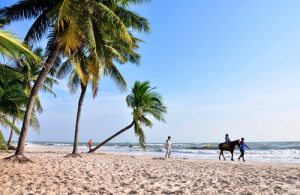
Hua Hin Horse Club Farm offers supervised trail and beach rides around the area. There are formal lessons and training with friendly staff, for all levels of riders. Alternatively, there are tens of ponies/small horses, actually based on Hua Hin beach during the day time, which you hire for a short supervised ride on a casual basis.
Khao Sam Roi Yot National Park
The park covers some 98 km², it’s located on the coast about 60 km south of Hua Hin. The first marine national park in Thailand, the name translates as “The mountain with three hundred peaks” which refers to a series of limestone hills. The northwest area is mainly freshwater marsh, which covers about 37% of the park, the largest wetlands area in Thailand. One of the main attractions in the park is Phraya Nakhon Cave which once served as a royal pavilion.
The park is also known for its rich wildlife, mangrove forests, beautiful beaches, limestone islands, trails and viewpoints. More than 350 bird species have been recorded in the park, which includes the purple swamphen, spotted brake, Malaysian plover, Kentish plover, white-bellied sea eagle, greater spotted eagle, oriental hobby, eastern marsh harrier and spoon-billed sandpiper. The forests clad mountains are also home to animals like the fishing cat, dusky leaf monkey, crab-eating macaque, Malayan porcupine, Indochinese serow, Sunda slow loris and barking deer.
Wildlife Friends Foundation Thailand Rescue Centre & Elephant Refuge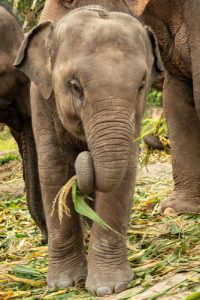
The wildlife rescue centre adopts and cares for abused, injured and abandoned animals that cannot be released back into the wild. It’s located 45 km northwest of Hua Hin and cares for over 700 animals, including bears, tigers, gibbons, macaques, loris and many birds. There’s also an affiliated elephant-rescue programme that helps them live freely. There’s also an option that includes a meet-and-greet with elephants. Hotel transfer from Hua Hin costs 200B per person but there’s also a small lodge on-site. Those looking for a more in-depth experience can volunteer at the centre. Drop-in visitors are not allowed.
Water Parks
Black Mountain Water Park – is located just 15 minutes from central Hua Hin. There’s a 55-foot-high (17-meter) tower with nine different slides, a wave pool, the lazy river, an infinity pool, and a children’s pool. The admission fee includes a free shuttle bus service from town.
Shopping
- Cicida Market – an open-air weekend arts and crafts market, with food and shopping in a relaxed atmosphere. It’s popular with both Thai and foreign tourists and there’s live music from about 8 pm onwards. The last (green) songthaew leaves about 9 pm back to town.
- Hua Hin Night Market – is situated in the town centre between the Petchkasem Road and the railway line, the market consists of one long street that starts up around 18:30. There’s lots of art and craft stuff, various bric-a-brac, DVD’s, clothes, etc. as well as a great variety of food for sale. In other words, it’s a typical Thai Market.
- Hua Hin Market Village – features an outdoor plaza and three levels of shops and restaurants, entertainment outlets and a multi-screen cinema. Its bright, airy complex, with a pleasant atmosphere and a more than a match for many of its Bangkok counterparts. The food court on the bottom floor serves up a particularly good selection of food at bargain prices.
Sightseeing
- Hua Hin Railway Station – Perhaps Thailand’s most icon railway station. Although built-in 1926 to replace the original station, it’s of Victorian design with lots of timber and ornate trim. The
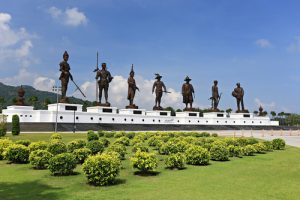
Rachaphakdia Park is a new but popular landmark in Hua Hin
quaint ticket office is very much in keeping with the station.
- Pa La-U Waterfall – The waterfall is remotely located in Kaeng Krachan National Park about 62km from Hua Hin. Unlike the rest of the park, it remains open during the wet season when it’s in full flow. There’s a walking trail that should be manageable to most visitors.
- Khao Taliab – is one of the biggest attractions in the area. Khao Takiab translates as ‘Chopstick Mountain’ although it’s much commonly referred to as Monkey Mountain, due to the large colony of macaques that have made their home there. There’s an imposing Buddhist temple on the hilltop, complete with an impressive stairway to the main shrine, but it’s the monkeys that tend to get most of the attention from visitors. Be warned – while feeding the monkeys is prohibited, they will rifle through your bags and belongings at every opportunity. Last but not least, there are great panoramic views and photo opportunities from the temple top.
- Ratchaphakdai Park – covering 36 hectares, it was only opened in October 2015. The park’s name means ‘the park that has been built with people’s loyalty to the monarchs. Standing 14m high and weighing 30 tonnes each, are seven bronze statues of some of Thailand’s most revered kings. A morning visit is best is recommended since there’s no shade at all in the park itself.
- Mrigadayavan Palace – with a seaside location, 12km north of Hua Hin, this summer palace was built in 1924 during the reign of Rama VI. Set in a stunning treed garden with fantastic sea views, it consists of 18 interlinked traditional teak buildings with tall, shuttered windows and patterned fretwork, that are built on stilts.
Nightlife
Hua Hin is certainly not as raunchy as some of Thailand’s other beach resorts, but there is plenty of lively entertainment for those who like to while the evenings with a few drinks. There are a couple of discos in town, notably the basement of the Hilton Hotel, as well as being a few bars and restaurants with live music. There’s also several British-style pubs and a few sports bars for those who just can’t afford to miss their favourite sport on a wide-screen TV.
The beer bar scene in Hua Hin is centred around Soi Bintaban, a soi (small road) located opposite the Hilton Hotel. Most of the bars have friendly hostesses who will be more than willing to share a drink with you. There’s also ‘Soi 80’, about a 10-minute walk from Bintaban, which is a 1 km long bar-lined street, with a slightly more chilled atmosphere.
Eating out
Hua Hin is famed for its great food, which is a particular draw for locals. Dining choices run the full gambit, from fancy top-notch restaurants to street stalls selling fresh seafood and other local cuisine and just about everything in between, as there are hundreds of places to eat in and around the town. And, apart from Thai, you’ll find a great choice of other available cuisines, including Italian, Chinese, Vietnamese, British, Indian and many more.
Where to stay?
If you plan to partake in the Hua Hin nightlife scene, then you should plan to stay near Central Hua Hin. There is a wide range of accommodation options in Hua Hin town centre, including family-friendly and budget choices. It’s probably the best area to stay if you want more than just lazy days on the beach as the likes of the night market, temples, bars and restaurants are all within a short distance. The beach itself is not far away, either.
For those who do want to laze around all day, there are dozens of luxury resorts spread along the coastline most of the way from Cha-am, about 30 km to the North. And for those looking for a more rustic experience, you can stay in a guesthouse that provides ‘wooden hut’ accommodation in the old pier area, adjacent to the beach. The gentle lapping of the waves is guaranteed to give you a great night’s sleep…………well, that and the Singha beer.
Prices can typically range from around THB 300 (£7.50) per night in hostel-style accommodation up to THB 20,000 (£500) for beachfront 5 star luxury for 2 adults sharing.


